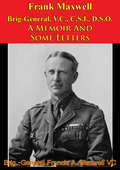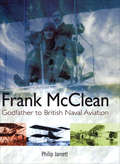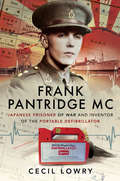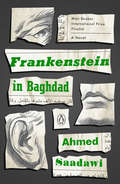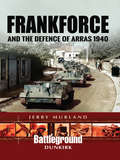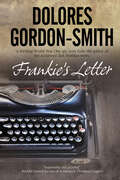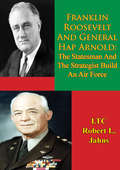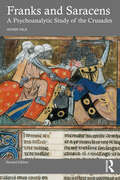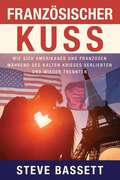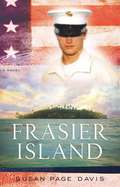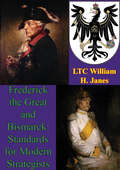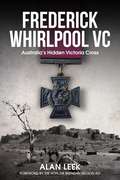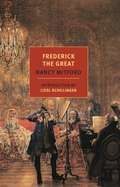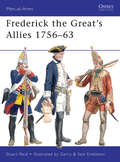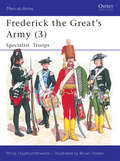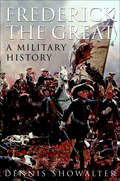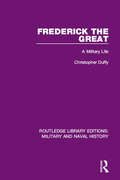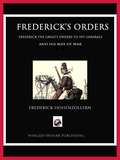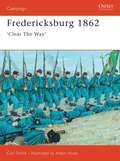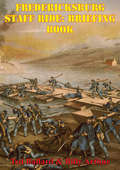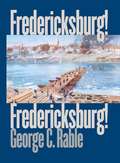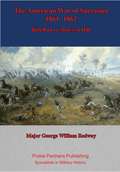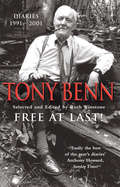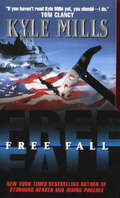- Table View
- List View
Frank Maxwell Brig-General, V.C., C.S.I., D.S.O. - A Memoir And Some Letters [Illustrated Edition]
by Brig.-General Francis A. Maxwell V.C.Includes the First World War Illustrations Pack - 73 battle plans and diagrams and 198 photos"If future generations desire to know what the British Regular officer was like at his best in the days of the War they will find some useful information in these pages. Brig.-General Maxwell--as he was when killed in actin.in September 1917--won the Victoria Cross in the African War, and officers of his regiment and brigade stated that he qualified for that greatest of all honours more than once in the Great War. His extraordinary personal bravery was matched by his chivalrous winning personality. "He was a King among men loved by everyone," wrote his orderly to Mrs Maxwell after his death. His letters are racy, interesting, valuable. He was one of the comparatively rare men loved war, thinking what a great and glorious life it would be "if one had no ties and love to make one look behind, instead of in front.""- Sir Cyril Falls.
Frank McClean: Godfather to British Naval Aviation
by Philip JarrettDuring aviations pioneering years Francis Kennedy McClean used his vast inherited wealth to help the now famous Short Brothers company become established as one of Britains greatest aircraft manufacturers and, in doing so, he helped the Royal Navys first pilots into the air. In effect, he was Godfather to British naval aviation.But McClean did much more than even that. He was himself a balloonist and pioneer aviator, flying with Wilbur Wright in France in December 1908. He provided the Royal Aero Club with one of the first flying grounds in the UK; personally purchased no fewer than sixteen aeroplanes from Short Brothers before the First World War, and also acted as the companys unpaid test pilot. Convinced that aviation was destined to play a vital role in the nations defence, he made his own aeroplanes freely available for training and ensured that the Navy had a suitable site from which to fly, founding Englands first naval flying school, at Eastchurch in Kent. His flight up the Thames to Westminster on 10 August 1912, during which he flew between the upper and lower spans of Tower Bridge and passed beneath the other bridges, caught the public imagination, but despite all these achievements he remained unassuming, modest and reticent. This is a fascinating and informative account of McCleans great influence on early aviation, and his achievements and significant contribution to naval aviation are revealed here for the first time.
Frank Pantridge MC: Japanese Prisoner of War and Inventor of the Portable Defibrillator
by Cecil LowryA biography of the British World War II veteran and Japanese POW camp survivor who went on to create a life-saving device.Countless thousands of men and women around the world have good reason to be thankful that Frank Pantridge survived three and a half years of brutal Japanese captivity. Had he not, they too would in all probability have died too.Taken prisoner at the fall of Singapore in February 1942, Frank was forced to endure appalling deprivation. Conditions on the Burma railway were notorious, and the death rate was horrendous.On returning to Belfast in late 1945, Frank specialized in heart diseases. Convinced that the prompt application of electric shock after cardiac arrest could save lives, he reasoned that ventricular defibrillation should be applied not just in hospitals but in the workplace, the home, the street or ambulance.His first “portable” defibrillator was produced in 1965 and over the intervening years evolved into the compact units so prevalent today. The importance of Pantridge’s invention was well demonstrated when U.S. President Lyndon B. Johnston’s life was saved in 1972.This stirring biography reveals the full story of a remarkable man who survived against the odds to save countless lives.Praise for Frank Pantridge MC“Cecil Lowry's book describes a man who…survived against all the odds. . . . A fascinating and moving story.” —Books Monthly (UK)
Frankenstein in Baghdad: A Novel
by Ahmed Saadawi<P>From the rubble-strewn streets of U.S.-occupied Baghdad, Hadi—a scavenger and an oddball fixture at a local café—collects human body parts and stitches them together to create a corpse. <P>His goal, he claims, is for the government to recognize the parts as people and to give them proper burial. <P>But when the corpse goes missing, a wave of eerie murders sweeps the city, and reports stream in of a horrendous-looking criminal who, though shot, cannot be killed. <P>Hadi soon realizes he’s created a monster, one that needs human flesh to survive—first from the guilty, and then from anyone in its path. <P>A prizewinning novel by “Baghdad’s new literary star” (The New York Times), Frankenstein in Baghdad captures with white-knuckle horror and black humor the surreal reality of contemporary Iraq. <P><b>Winner of the International Prize for Arabic Fiction <P>Winner of France’s Grand Prize for Fantasy <p>2018 Man Booker International Shortlist</b>
Frankforce and the Defence of Arras 1940 (Battleground Dunkirk)
by Jerry MurlandThere is no other city in France that has the same associations in time of conflict that the British have with Arras. Since the campaigns of John Churchill, 1st Duke of Marlborough, in the early 18th century, British soldiers have fought in and around Arras, occasionally as an enemy but, more often, as defenders of French and Allied democracy. Battlefield visitors to the area will immediately recognize the names of towns and villages that were as significant to the men of Marlboroughs army as they were to those who fought in the First and Second World Wars.This book serves both as guide to the Second World War battlefields that surround the city and its environs as well as detailing the actions of the British armored attack of 21 May 1940. The book looks at the strategic situation that led up to the famous Arras counterstroke and, using material that has not been published before, examines the British and German actions between 20 and 23 May. The only Victoria Cross action that took place during this time is looked at in detail; as is the fighting that took place in Arras and during the breakout.Despite its shortcomings, the counterstroke achieved the essential element of surprise and caused widespread alarm amongst the German command and hit Rommels 7th Panzer Division at precisely the moment when his armored units were ahead of the infantry and gunners. The British infantry fought well and both the Durham battalions were fortunate that their commanding officers and senior NCOs were men who had already fought in one conflict and possessed the determination to rally their less experienced junior ranks and fight on regardless. Such was the case with the two tank battalions, although sadly they lost both their commanding officers and over half the tanks that went into the engagement. The attack did enable the British to tighten their hold on Arras albeit temporarily and, as is often cited, built doubts in the minds of German High Command as to the speed of their advance and contributed to the subsequent Hitler halt order of 24-27 May.The author has gone to some lengths to track down accounts from those individuals who served in the area during May 1940 and fought the enveloping tide of the German advanceThe book is supported by three car tours, one of which takes the visitor along the tragic path taken by the Tyneside Scottish on 20 May and two walking routes, which concentrate on Arras.137 black and white photographs (integrated) and a number of maps derived from regimental histories; and six tour maps provide the battlefield visitor with illustrations of the battlefields as they were in 1940 and as they are today.
Frankie's Letter
by Dolores Gordon-SmithThis WWI spy thriller &“packed with adventure, action, and unforeseen twists&” by the author of the Jack Haldean mysteries &“will appeal to Ken Follett fans&” (Booklist). It&’s 1915, and Dr. Anthony Brooke has been called away from his medical practice to spy for the British Crown. But now it seems his mission has been compromised. In a hotel in Kiel, Germany, a colleague&’s dying words are, &“There&’s a spy in England . . . Frankie&’s letter. Read Frankie&’s letter . . .&” But Anthony hasn&’t a clue who Frankie might be. With his cover blown and the German army at his heels, Anthony&’s search for the truth leads him to a seemingly innocent estate in the English countryside. Here, in the home of a British publishing magnate and his beautiful French wife, Anthony uncovers a web of spies, treachery, and terrorists as the war gets closer—and becomes all too personal. &“[An] exciting spy thriller full of period charm.&” —Kirkus Reviews &“Dolores Gordon-Smith keeps her plot twisting and turning.&” —Historical Novel Society
Franklin Roosevelt And General Hap Arnold: The Statesman And The Strategist Build An Air Force
by LTC Robert L. JahnsStatesman and soldiers: What is the relationship that exists between the policymaker and the strategist? And, when the policymaker is actively involved in determining the strategies, what is the effect of advice given by the senior military leader and what role should he play in formulating policy and strategy? Given that military officers will continue to provide advice and service to civilian leaders, how do these relationships between the statesman and strategist influence or shape the outcome of policymaking, and can successes or failures be attributed to these personal relationships? This study seeks to examine those questions by reviewing the relationship of the somewhat controversial General Hap Arnold and the President of the United States, Franklin Delano Roosevelt. The study will initially focus on the strategist, General Arnold, as he developed personally, and some of the background history and politics in the development of the Army Air Forces. Approaching the World War II era, the focus will shift to the building of the world's greatest air force and the winning of World War II. It will examine the personalities, politics, and policies of the President of the United States in their relationship to General Arnold and other service chiefs. The paper will conclude with thoughts on the relationships between policymakers and strategists to determine if those relationships are still important today and if so, how the strategist can best prepare for this relationship.
Franks and Saracens: A Psychoanalytic Study of the Crusades
by Avner FalkFranks and Saracens is the first and only book to examine the Crusades from the viewpoint of psychoanalysis, studying the hidden emotions and fantasies that drove the Crusaders and the Muslims to undertake their terrible wars.Using original documents as well as secondary sources, Avner Falk demonstrates that the deepest and most powerful motives for the Crusades were not only religious or territorial – or the quest for lands, wealth, or titles – but also unconscious emotions and fantasies about one's country, one's religion, one's enemies, God and the Devil, Us and Them. The book demonstrates the collective inability to mourn large-group losses, and the collective needs of large groups such as nations and religions to develop a clear identity, to have boundaries, and to have enemies and allies. Falk investigates the unconscious dynamics of the Crusades, both on the individual and on the collective level, to understand why the Crusading fantasies persisted for nearly two centuries, and why the “northern Crusades” went on until the early fifteenth century. This updated edition adds a new chapter on collective trauma both as cause and as consequence of the Crusades and has been fully revised to include literature on trauma and other psychological aspects of the Crusades.Franks and Saracens will be of great interest to historians, political scientists, medievalists, psychologists, psychiatrists, psychoanalysts, anthropologists, and sociologists interested in questions of conflict, fantasy, and identity, collective psychological processes, and to academics of the Crusades and military history.
Französischer Kuss: Wie sich Amerikaner und Franzosen während des Kalten Krieges verliebten und wieder trennten
by Steve BassettDie Geschichte von Châteauroux ist geprägt von den unauslöschlichen Spuren der amerikanischen Präsenz. Als die ersten Piloten der amerikanischen Armee 1917, kurz vor dem Ende des Ersten Weltkriegs, zur La Martinerie Air Base in Châteauroux kamen, hätten sie zweifellos nie gedacht, dass sie der Beginn einer Liebesbeziehung zwischen Berry und dem Star sein würden, die ein halbes Jahrhundert dauerte -Geschmücktes Spruchband. Als die Amerikaner 50 Jahre später zusammen mit allen anderen NATO-Truppen aus Frankreich abzogen, verursachte dies ein echtes Trauma in der Stadt, sowohl im Geiste als auch im Alltag. Seitdem hat sich vieles verändert. Der Schmerz verging mühsam, bei manchen eitern die Wunden noch, aber das Jahrhundert hat sich geändert. Châteauroux baute sich neu auf und entwickelte sich weiter, um endlich eine wichtige Stadt im neuen Europa zu werden. Steve Bassetts Buch zeigt, dass jenseits des Atlantiks in einer Provinzstadt Frankreichs die Erinnerung an diese amerikanische Zeit sehr langlebig ist, ein Beweis unserer unbestreitbaren Liebe zu dieser großartigen Nation, die die Vereinigten Staaten von Amerika sind.
Frasier Island (Frasier Island Series, Book #1)
by Susan Page DavisBack Cover WILL RACHEL'S FIRST TOP SECRET ASSIGNMENT PROVE TO BE HER LAST? * * * After specialized underwater training, Ensign Rachel Whitney of the U.S. Navy is posted to a remote island in the North Pacific, a tiny scrap of rock guarding a highly classified secret. She could love her new assignment if her commanding officer, It. George Hudson, weren't so difficult to please. Despite George's first reaction to her presence on the island, Rachel sets out to prove she is perfect for the job. She doesn't dream of being a heroine-or falling in love-but when word leaks out about the prize they are guarding, Rachel and George find that they have few resources besides each other and their faith in God to thwart an enemy attack that could endanger all of America. * * * Let this romantic and exciting adventure take you to a place where fear meets faith and weakness is exchanged for unexpected strength.
Frederick The Great And Bismarck: Standards For Modern Strategists
by LTC William H. JanesMakers of modem strategy have an unprecedented challenge in our complex world. American strategists have been criticized for strategic failures since World War II. Congressional investigations have been initiated to examine the strategic education of senior military officers. The news media is replete with criticism of our strategy. The lingering question is how can a nation with our sophisticated educational system and highly intelligent leaders fail to develop a coherent, consistent, and productive strategy? This study examines two historical strategists, Frederick the Great and Otto von Bismarck, to determine if history provides any solutions for modern strategists.The study uses Michael Howard's elements of grand strategy. Five elements of grand strategy are discussed: operational, logistical, social, technological, and political. Frederick's and Bismarck's use of these elements is examined during the times they dominated policy making in Prussia. Their methods provide valuable insights about strategy development. This paper does not provide a solution to our modern problems with strategy. Rather, it focuses on two models. One model contains the elements of grand strategy. The second model provides criteria to evaluate the development and execution of strategy: determination, consistency of purpose, realism, creativity, vision, flexibility, and decisiveness.The conclusions verify Frederick's and Bismarck's strategic effectiveness. Frederick as King and Bismarck as Prime Minister provide numerous examples of successful implementation of grand strategy. Although our world is more complicated, there are definite applications for the modern strategist.
Frederick Whirlpool VC: Australia's Hidden Victoria Cross
by Alan LeekFrederick Whirlpool’s Victoria Cross is displayed near the entrance to the Hall of Valour at the Australian War Memorial, Canberra. It was the first VC pinned to an Australian uniform, yet almost nothing was known about its enigmatic recipient. Two acts of valour during the Indian Mutiny, won him the Victoria Cross, but 17 severe sword wounds ended his career. Arriving in Victoria in 1859, he became a volunteer rifleman and school teacher. His VC was presented in Melbourne in 1861. He was an applicant to join the Victoria Police, but a corrupt recruitment process and unsolicited political interference prevented it. Repulsed by fame, he fled and hid his cross from the world. Fragments of his story were known, but since 1895, they have been tainted by error, guesswork and in one recent British work, pure fantasy. This work solves an old mystery. It reveals his true identity and early life in Ireland before joining the East India Company Army. To understand his service, the Central Indian campaign under Sir Hugh Rose, is examined in some detail, something that has not been done before. The real horrors of that campaign are revealed to show their devastating impact on this sensitive man. Rich sources reveal his anguished story. Humphrey James&’ reasons for changing his identity and leaving his family forever, are unearthed. His life in Australia is revealed, showing his fall, firstly from policing and then teaching, in NSW. He undoubtedly struggled with his demons and believed that he was destined for eternal damnation. The passage of his Victoria Cross, after his death was unknown before it appeared on the market in 1927. Its movements and those of his Indian Mutiny medal with its Central India clasp, are now revealed&’ This fascinating story fills huge gaps in the narrative of this ordinary man, whose life is deserving of factual interpretation. It is a story of heroism, suffering and failure, but the forgotten man will triumph in its telling. His sad life ended as a recluse in 1899, and he was buried in an unmarked grave in Windsor. The only mourner who attended his funeral left a thread, which has allowed painstaking research to uncover the true story of this sad and purposefully enigmatic hero.
Frederick the Great
by Nancy Mitford Liesl SchillingerThe Prussian king Frederick II is today best remembered for successfully defending his tiny country against the three great European powers of France, Austria, and Russia during the Seven Years' War. But in his youth, tormented by a spectacularly cruel and dyspeptic father, the future military genius was drawn to the flute and French poetry, and throughout his long life counted nothing more important than the company of good friends and great wits. This was especially evident in his longstanding, loving, and vexing relationship with Voltaire. An absolute ruler who was allergic to pomp, a non-hunter who wore no spurs, a reformer of great zeal who maintained complete freedom of the press and religion and cleaned up his country's courts, a fiscal conservative and patron of the arts, the builder of the rococo palace Sans Souci and improver of the farmers' lot, maddening to his rivals but beloved by nearly everyone he met, Frederick was--notwithstanding a penchant for merciless teasing--arguably the most humane of enlightened despots.In Frederick the Great, a richly entertaining biography of one of the eighteenth century's most fascinating figures, the trademark wit of the author of Love in a Cold Climate finds its ideal subject.
Frederick the Great's Allies 1756-63
by Gerry Embleton Stuart ReidThe Seven Years' War in Germany was characterised by an increasing use of 'light' troops in conjunction with regular infantry and cavalry as part of an ongoing evolution in military tactics. This book draws attention to these tactical developments and also provides an analysis of the allied army that fought alongside Frederick the Great in Germany. Composed of troops from the electorate of Hanover and contingents from Hessen-Kassel, Brunswick and Prussia, this force was funded by Britain and led by a Prussian officer, Prince Ferdinand of Brunswick. Later, British troops joined this army as it operated throughout western Germany, and together the allied army won a great victory at the famous battle of Minden in 1759.
Frederick the Great's Army
by Bryan Fosten Philip HaythornthwaiteFrederick the Great was not renowned as a great artillery enthusiast, however he did recognise the importance of artillery and greatly expanded the arm. Frederick was also aware of the value of strong fortifications as barriers against the manoeuvres of enemy armies, and as places of security for troops and magazines; some of these were of vital significance in the survival of Prussia during the Seven Years' War (1756-1763). This fascinating volume by Philip Haythornwaite examines the artillery, engineers and others specialist troops of Frederick the Great's army.
Frederick the Great: A Military History (Modern Wars In Perspective Ser.)
by Dennis ShowalterA biography of the Prussian king and military legend from &“America&’s leading historian&” (Jeremy Black, author of Imperial Legacies). Famed for his military successes and domestic reforms, Frederick the Great was a remarkable leader whose campaigns were a watershed in the history of Europe, securing Prussia&’s place as a continental power and inaugurating a new pattern of total war that was to endure until 1916. However, much myth surrounds this enigmatic man, his personality, and his role as politician, warrior, and king. From a renowned military historian and winner of a Pritzker Literature Award, this book provides a refreshing, multidimensional depiction of Frederick the Great and an objective, detailed reappraisal of his military, political, and social achievements. Early chapters set the scene with an excellent summary of eighteenth-century Europe and the Age of Reason; an analysis of the character, composition, and operating procedures of the Prussian army; and an exploration of Frederick&’s personality as a young man. Later chapters examine his stunning victories at Rossbach and Leuthen; his defeats at Prague and Kolín; and Prussia&’s emergence as a key European power. Written with style and verve, this book offers brilliant insights into the political and military history of the eighteenth century—and one of history&’s most famous rulers.
Frederick the Great: A Military Life (Routledge Library Editions: Military and Naval History)
by Christopher DuffyFor tactical and strategic ingenuity, for daring and ruthless determination and the capacity to inspire troops, Frederick the Great was without equal. In this detailed life of ‘Old Fritz’, Christopher Duffy, who has written widely on the army of Frederick and on the armies of his adversaries, Austria and Russia, has produced a definitive account of his military genius.
Frederick's Orders: Frederick the Great's Orders to His Generals and His Way of War
by Vincent W Rospond Frederick HohenzollernAt various times in his military career Frederick the Great seemed on the cusp of a major defeat, yet always to find ways to extricate himself a secure a victory for himself and his lands. Frederick has long been considered in the pantheon of military leaders for his strategic and tactical prowess. His instructions to his generals have long been considered a starting point to understand the military mind of this leader. We present an annotated and illustrated version of Frederick the Great's 1754 Instructions to his infantry and cavalry. Included in this volume are maps that provide a background to his battles, a biography of Frederick and some of his generals, and an explanation of 18th century warfare as well as illustrations of his troops.
Fredericksburg 1862
by Carl Smith Adam HookOsprey's examination of the Battle of Fredericksburg of the American Civil War (1861-1865). In December 1862, things were still confused for the Union. Antietam had been a failure for both sides, and although the battle showed that the Union army could bring the Confederates to bay, it couldn't pin them in one place long enough to destroy them. In December 1862, General Burnside, newly appointed to command the Army of the Potomac, planned to seize and secure the town of Fredericksburg, and then take the Confederate capital of Richmond. Carl Smith's book details the epic struggle that engulfed the Union side as it crossed the Rappahannock on December 11, encountering stiff opposition from Lee's men.
Fredericksburg Staff Ride: Briefing Book [Illustrated Edition]
by Ted Ballard Billy ArthurContains more than 20 maps, diagrams and illustrationsThe movement and details of the Union offensive plan at Fredericksburg seemed to be understood by all senior commanders; the North had a preponderance of manpower and artillery; a bridgehead was established on the enemy side of the river and initial objectives secured. Why did Burnside decide to withdraw his army back across the river to its original position? That question cannot be answered without viewing the pontoon crossing sites, the Union approach routes, the infamous "stonewall," and the other Confederate defensive positions. Accordingly, the purpose of a Fredericksburg staff ride is to visit these and other locations on the battlefield and analyze the battle through the eyes of the men who were there, both leaders and rank and file soldiers.
Fredericksburg! Fredericksburg!
by George C. RableDuring the battle of Gettysburg, as Union troops along Cemetery Ridge rebuffed Pickett's Charge, they were heard to shout, "Give them Fredericksburg!" Their cries reverberated from a clash that, although fought some six months earlier, clearly loomed large in the minds of Civil War soldiers. Fought on December 13, 1862, the battle of Fredericksburg ended in a stunning defeat for the Union. Confederate general Robert E. Lee suffered roughly 5,000 casualties but inflicted more than twice that many losses--nearly 13,000--on his opponent, General Ambrose Burnside. As news of the Union loss traveled north, it spread a wave of public despair that extended all the way to President Lincoln. In the beleaguered Confederacy, the southern victory bolstered flagging hopes, as Lee and his men began to take on an aura of invincibility. George Rable offers a gripping account of the battle of Fredericksburg and places the campaign within its broader political, social, and military context. Blending battlefield and home front history, he not only addresses questions of strategy and tactics but also explores material conditions in camp, the rhythms and disruptions of military life, and the enduring effects of the carnage on survivors--both civilian and military--on both sides.
Fredericksburg, 1862: A Study Of War [illustrated Edition] (Special Campaigns Series #3)
by Major George William RedwayThis ebook is purpose built and is proof-read and re-type set from the original to provide an outstanding experience of reflowing text for an ebook reader. Includes Civil War Map and Illustrations Pack - 224 battle plans, campaign maps, and detailed analyses of actions spanning the entire period of hostilities. Major Redway picks up his analysis of the actions in the Eastern theatre of the Civil War with his widely acclaimed book on the Fredericksburg campaign of 1862. Goaded by his political master Lincoln, Major-General Burnside assumed the offensive with the Union army in late 1862, planning to use speed and surprise to enable him to defeat the Confederate forces under Robert E. Lee. His plan started to fall apart almost immediately as he failed to move with the requisite speed and, faced with choices between vaciliation and bold action, assumed the former. What had started badly was to end disastrously for the Union forces at the Battle of Fredericksburg, as bloody frontal assaults were delivered against entrenched Confederate troops. This book is part of the Special Campaigns series produced around the turn of the 20th century by serving or recently retired British and Indian Army officers. They were intended principally for use by British officers seeking a wider knowledge of military history. Title - Fredericksburg, 1862 : A Study of War Series Name - Special Campaigns Series Series Number --3 Author -- Major George William Redway (1859-1934) Text taken, whole and complete, from the edition published in 1906, London, by Swan Sonnenschein & Co. Original - xv and 297 pages. Illustrations - The maps cannot be reproduced with this volume as they are A3 - 224 additional maps have been added.
Free At Last: Diaries 1991 - 2001
by Tony BennTony Benn is the longest serving MP in the history of the Labour Party. He left Parliament in 2001, after more than half a century in the House of Commons, to devote more time to politics. This volume of his Diaries describes and comments, in a refreshing and honest way, upon the events of a momentous decade including two world wars, a change of government in Britain and the emergence of New Labour, of which he makes clear he is not a member. Tony Benn's account is a well documented, formidable and principled critique of the New Labour Project, full of drama, opinion, humour, anecdotes and sparkling pen-portraits of politicians on both sides of the political divide. But his narrative is also broader and more revealing about day-to-day political life, covering many aspects normally disregarded by historians and lobby correspondents, relating to his work in the constituency, including his advice surgeries. This volume also offers far more of an insight into Tony Benn's personal life, his thoughts about the future and his relationship with his family, especially his remarkable wife Caroline, whose illness and death overshadow these years. Tony Benn is a unique figure on the British political landscape: a true democrat, a passionate socialist and diarist without equal. With this volume, his published Diaries cover British politics for over sixty years. It is edited, as are all others, by Ruth Winstone.
Free Fall
by Kyle MillsFrom the #1 New York Times bestselling author of Vince Flynn's Mitch Rapp SeriesIt's bold. It's dangerous. It's the kind of maverick operation that has made Mark Beamon both the FBI's best agent and its least-likely-to-succeed screw-up.A top-secret FBI file -- buried in an anonymous government warehouse since J. Edgar Hoover's death -- is missing. The unlucky grad student who uncovered it is dead, and now his ex-girlfriend is on the run, accused of the murder. The only man everyone agrees can find the young woman and turn up the explosive document is "off-duty," suspended and under the threat of prosecution by the bureau itself.Beamon knows better than anyone that this is his last shot to save his career -- and his country. Tracking the young woman down, though, will be the hardest assignment he's ever tackled, for she's a gutsy world-class rock-climber who can drop out of sight anywhere in the world. And even if he finds her and the file, who can he trust when the FBI itself is under suspicion? Beamon has no room for wrong guesses -- or moves. If he blows this one, he'll free fall straight out of the bureau -- and straight into prison....
Free Fall (Elite Ops #3)
by Emmy CurtisFrom the author of the Alpha Ops series comes an action-packed, super sexy military romance. A legend among black ops teams, Col. Duke Cameron can't wait to get back in action again--no matter how high the risk. Two of the world's best military pilots are missing after a midair collision, and he's made it his job to find out why.U.S. Air Force veteran Casey Jacobs loves working for a cutting-edge, high-tech company - until she suspects their newest design might have caused a horrible plane crash. But after a few "accidents," it's clear no one wants her asking too many questions. The only person she trusts to help her is Duke, the sexy secret crush from her flying days who still turns her on like no one ever has.But someone is watching their every move, making sure they don't uncover the truth. And when the danger turns physical, it's not just their love that's on the line. It's their lives."Dangerous secrets and undeniable chemistry are the hallmarks of Curtis's steamy third Elite Ops contemporary military romantic thriller." -Publishers Weekly "Very thrilling, with lots of action and lots of sex. Recommend for those who read Julie Walker." -Library Journal
